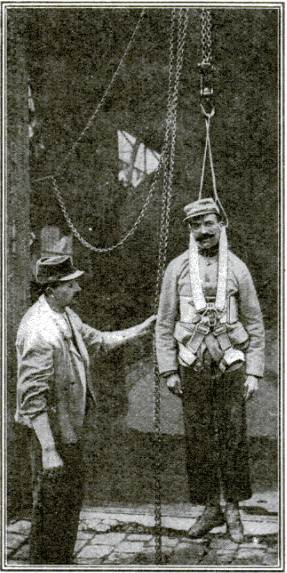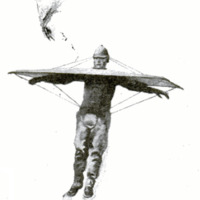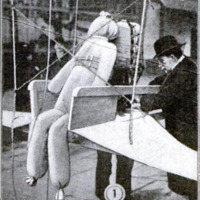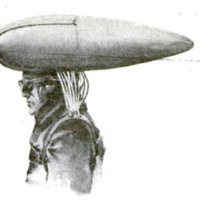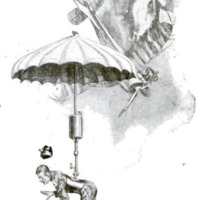-
Titolo
-
The difficulties encountered in the development of parachute technology
-
Article Title and/or Image Caption
-
Title: Parachuting to Safety
-
Subtitle: Why it is hard to provide the right kind of parachute to save brave men whose flying-machines have been crippled
-
extracted text
-
FOR the same reason that sailors
are not responsible for the adop-
tion of life-preservers and are
notoriously poor swimmers, aircraft
pilots set their faces against safety de-
vices. The parachute is almost as old
as the balloon; yet no aeronaut would
use it except to make farmers at county
fairs gasp in astonishment at the sight
of a man releasing himself from a fire-
balloon, stepping into space, and float-
ing down safely, slowly, and grace-
fully with a giant umbrella.
In the great war of the nations we
saw the first wholesale use of the para-
chute by officers who had been sent
aloft in captive “sausage” balloons to
watch the effect of artillery fire on the
enemy, and who had to jump for their
lives when the hydrogen-filled en-
velope by which they were supported
became a target for incendiary ma-
chine-gun bullets fired from hostile
airplanes. Time and time again, they
had seen a comrade drop from the
clouds with sickening swiftness. They
had seen brave Lufberry un-
strapping himself and leaping
overboard from his ignited craft
after an encounter with a German
armored plane. They had seen
men vainly struggling to right
machines the controls of which
had been shot away. And yet,
they persisted in rejecting the
only form of life-preserver that
could possibly be used.
Reason Behind the Prejudice
Behind this unwillingness to
equip the airplane with an ob-
viously necessary safety device
lie both prejudice and solid
sense. It is one thing to drop
from a balloon or airship with a
parachute—quite another to drop
from a flying-machine. In a
gas-supported craft a man has a cer-
tain freedom of movement, for which
reason the act of ‘stepping over”
is no more difficult than leaping
from a high roof. In an airplane
it is otherwise. Although he can
unbelt hiruself, rise from his seat,
and leap overboard, the problem of
providing him with a trustworthy
It’s Supposed to Work in
Air and Water
David Williams Ogilvie invented i
life-preserver to save a man not only
from being dashed to pieces, but also
from drowning. The aviator is to
wear a “foundation” garment that re.
sembles a one-piece bathing suit, and
over this a double-walled rubber suit,
which can be blown up with air.
Ogilvie thinks that the air will miracu-
lously help to break the fall if the para-
chute should fail to work. The para-
chute (too small to be of any service)
is fitted to a collar and to ribs like those
of an umbrella. Just raise your arms
and the parachute opens. But there
are 50 many things the matter with
Ogilvie's invention that we really can’t
begin to enumerate them all here.
But It's
Only
a Dummy
‘This photograph of
Borer Sos
prod Tae
the cannon has been
automatically fired seems to make out a case
for the Baron; but it is our opinion that he
has not even begun to nibble at the problem.
life-preserver is accompanied with
grave mechanical difficulties. The
parachute” must be extraordinarily
compact when folded; it must be stow-
ed away so that it will not hamper the
pilot; it must not retard the machine
in flight; it must not foul the rigging
at the crucial moment.
Mechanical Difficulties
But this is not all. The flight of an
airplane is mechanically so_different
from the drifting of a free balloon that
Would It Work with a Man?
Baron Odkolok of Paris is here shown ad-
Justing his invention to a dummy seated in a
dummy machine. In the bundle behind the
dummy the parachute is contained. Like
most inventors who have busied themselves
with making flying safe, the Baron thinks that
everything depends on the parachute. releasing
mechanism. He connects the parachute rope
with a small string, and the string in turn
with a little cannon. The aviator unbelts
himself, rises, fires the cannon, and thus re-
leases the parachute. See the picture above.
it may be necessary to jerk the
pilot out of the machine by means
of the parachute itself. When, for
example, the controls of a machine
have been shot away and the ma-
chine drops in a flat spin, the aviator
who has leaped overboard may find
himself overtaken by the plane,
and his parachute torn to shreds
by the propeller.
What of the Peace Machine?
Similar objections might be raised
against the use of life-preservers at
sea. No one demands that a life-
belt shall save an ocean liner's
passenger in every perilous situ-
ation; neither should a parachute
be expected to save an aviator
in the most freakish of accidents.
In warfare, it is true, machines are
shot down from the ground, in which
case there is no chance to use a
life-saver. But what of the peace
machine? What of the thousands of
machines in which zealous young men
learn how to fly? What of the mail-
carrying machines?
How They Land Sometimes
When a balloonist “steps over,” his
heart is in his throat, even though the
parachute has opened with a roar.
Over the battlefield a hostile machine-
gunner in the air may try to pick him
off during the slow descent. And even
though he escaped the machine-gun
bullets, he might find himself dangling
helplessly from a tree in the branches
“of which his drifting life-preserver has
become entangled. ~ Artillery officers
who went up in balloons to observe the
effect of gunfire were taught how to
use the parachute in real schools. Mr.
Calthrop, an English engineer, advo-
cates similar training for airplane pilots.
McLaughlin, an
American inventor,
proposes to have
the aviator carry
the parachute on
his head. We have
taken his idea and
improved it so that
it may conceivably
work. We're not
sure but the aviator's neck would be broken |
when he is yanked out by a parachute that
suddenly opens in the 120-mile gale created
by a swiftly dropping machine, and so we
have attached the parachute sling to the
aviator's shoulder-harness. We would pack |
McLaughlin's parachute in a headpiece, |
streamlined like an airplane fuselage. The
shell forming part of the streamlined para- |
chute bundle falls off when a button is
pressed. The parachute, open as its mouth,
catches the gale created by the falling machine.
A far more valid objection is the
weight of even the lightest parachute.
Let it not be forgotten that an airplane, |
and above all the 120-mile-an-hour
single-seater, is a structure in which |
ounces must be saved; otherwise
it cannot fly high or fast. Clearly,
a parachute weighing thirty or even
forty pounds may not be added |
without lowering the machine's flying
efficiency.
It is obviously difficult to mount
the parachute on a flying-machine of
the pusher type that is, a machine on
The Way the Germans Did It |
The Germans seem to have been the
first to use the parachute in actual battle. |
Time and time again it was reported that
their airmen were equipped with such acrial |
life preservers. A few of them certainly |
were. Here we have one of their crude devices |
—an_ umbrella folded into pillow form and
attached to the usual aviator's harness.
How well this worked, we don't know as |
yet, because no official reports on the sub-
Ject have been published by the Germans.
‘which the propeller is mounted in the
rear, as in a steamship; for the para-
chute may foul the under-carriage in
the process of opening. With a trac-
tor type of machine, however, the para-
chute can be housed in the rear portion
of the fuselage. All things considered,
the best type of parachute for air-
planes would be one in which the
parachute is launched upward.
Zeppelins Had No Parachute
So far as we have been able to
determine, the Zeppelins were
not provided with any form of
parachute, despite the fact that
it would be far easier to leap
overboard from a giant dirigible
than from an airplane. The
horror of twenty-two men burned to
death two miles in the air, as the result
of a single flaming bullet which has
found its mark in the huge volume of
hydrogen with which the envelopes
are inflated, can be imagined. No won-
der they often leaped overboard in the
hope of finding a mercifully swift es-
tinction below. Even the man in an
airplane that has been crippled has a
better chance of escape than the
stricken members of a Zeppelin that has
been hit; for time and time again air-
planes, by reason of their inherent
stability, have actually reached the
ground in safety, even with their con-
trols shot away.
Will the Parachute Open?
The man who drops from a balloon
with a parachute abandons himself
to a precipitous fall, placing his con-
fidence in the opening of the umbrella
in time to break his fall. Parachuting
of that kind is out of the question from
an airplane, as a general rule. A mod-
ern airplane, even in straightaway
flight, travels at a speed of from 90
to 120 miles an hour. When it
plunges to the ground its velocity is
certainly no less.
Most inventors have failed utterly
to realize what a veritable storm is
created by a high-powered machine,
whether it speeds on normally or
whether it falls like a bullet. They
seem to argue that the whole problem
consists in providing some push-button
releasing device that will free the
aviator and the parachute in a perilous
moment.
The inventor who has unquestion-
ably given the airplane parachute the
most thought, and who has demon-
strated the correctness of his views
most conclusively by the severest im-
aginable tests, is an English engineer,
Mr. E. R. Calthrop. Those who
remember the earlier tragedies of
flying will recall that one of the first
Englishmen to fly was the Honorable
Charles Rolls, whose name is
identified with the Rolls-Royce
car. Rolls bought a Wright
biplane of an early model—a
machine built at a time when
very little was known of the
enormous strains to which sup-
porting surfaces are subjected
in flight. He lost his life in
1910 because of some structural
weakness.
Result of His Friend's Death
Calthrop was a friend of his.
It was the tragie death of Rolls
that impelled Calthrop to concen-
trate his engineering attention on
the invention of a parachute that would
meet the requirements of the aviator.
Calthrop has patented several types of
parachutes. The accompanying illus-
trations picture the details of his most
important designs so clearly that it is
unnecessary to elaborate on them here.
For the immediate purpose, it is suffi-
cient to explain that in its more
To Save Man and Machine
Stick a closed umbrella through the |
‘top of your machine
and the handle into
the mouth of a small
cannon, and you
are applying the
ideas of George
Giem. George has
the gun so arranged
that if the engine
should stop, the
un goes bang! and
the parachute _is
discharged. But
suppose George
shuts off the motor
‘when gliding down?
A locking _ device
prevents the gun
from going off. It
is clear that George
really does not
know” very much
about the problem.
approved form the Calthrop parachute
is folded compactly between two disks,
each about two feet in diameter, and
connected with the machine by a
shock-absorbing sling about fourteen
feet long. The only free fall encoun-
tered is limited to the length of this
sling, and it lasts less than a second.
No Shock to the Nerses
According to Mr. Calthrop, “the
‘whole operation of opening takes only
two and one half seconds, and there is
no shock whatever to the nerves.”
In unfolding, the sling and the par-
achute itself fall outside of thedisks, the
effect being that a cylinder of air is
inclosed so that outside air-pressure
may not prevent the parachute from
opening. Such is the system of pack-
ing that the whole action is progressive.
It was in the autumn of 1917 that
the Calthrop parachute was publicly
tested. An officer leaped from the
top of the London Tower Bridge into
the Thames below—a sheer drop of
175 feet. The test was made for the
express purpose of demonstrating the
possibilities of the invention at low
altitudes. It proved a complete suc-
cess. The actual drop was about 140
feet, which shows that even when fly-
ing very low in an uncontrollable ma-
chine an aviator still has a chance for
his life if he leaps overboard with such
a safety device.
In the present year Captain Sarret
of the French army tested the para-
chute successfully from an airplane
at a far greater height from the ground.
Sarret’s machine was under control of
a pilot. Before the war, however,
Pégoud, who first looped-the-loop in
the air, demonstrated the possibilities
of an ordinary para-
chute—a very much
cruder contrivance
than Calthrop's—by
boldly jumping over-
board with it from a
single-seater.
Such is the rush of
air produced by a
‘modern fast airplane
that even if it were
flying very low—as
‘low, for example, as
twenty-five or thirty feet
from the ground—the para-
chute would still be effective 4
if it is so constructed as to pull
the pilot out of his seat. Indeed,
a man might thus even leave a sixty-
mile-an-hour railway train in safety.
Schools to Teach Parachuting
Mr. Calthrop has urged the need of
schools in which aviators will be taught
how to use the parachute. It is al-
most self-evident that, no matter how
desperate his predicament, an aviator
will try to master his uncontrollable
machine. The parachute is not likely
to be resorted to until it flashes upon
him that it is his one means of salva-
tion. That is not likely to happen
until the machine is within a thousand
feet or so of the ground. Although
Mr. Calthrop has conclusively demon-
strated that his parachute will operate
when it is only a few hundred feet
above the ground, it would be foolish
to maintain that the parachute would
be effective in every desperate situa-
tion, or that it is not more likely to be
effective at greater than at lesser
altitudes. The untrained aviator will
probably be so crazed by the fear of
Kaja T. Togstad thinks this solves the para-
chute problem. The can that Kaja would
have you carry on your back contains a spring
which raises the umbrella when it is time to
jump. The little insert shows Togstad s de-
vice in its inoperative position, when the pilot
is flying along, recking not of shrapnel or
machine-gun bullet. The other picture shows
what happens when the machine is struck .
the fate that is impending that he will
never think of using the one possibility
of escape. Afterall, aviators are taught
at present only to fly, and not
to save themselves in an ex-
tremity. For that reason,
Mr. Calthrop’s suggestion that
parachuting as well as flying
be taught seems to us emi-
nently sane.
Jerked to Safety
E. R. Calthrop is the inventor of
this ingenious parachute. The rush
of air past a plane, which has made
parachuting seem difficult to most
inventors, is utilized so that the
umbrella must inevitably open in
the precious fractions of a second
that may separate safety from
death. The parachute is packed in
aforwardly inclined container, and connected by a cord and shock- |
‘absorber with the aviator's harness. When a lever in front of the
aviator is pulled, his seat and its back fall into the positions
shown by dotted lines. Compressed air is admitted from a |
reservoir at the bottom of the fuselage to the parachute-container,
and the hinged bottom of the container falls, 50 as to scoop air |
into the container and assist in cjecting the parachute. The |
aviator is actually pulled out of his seat. The parachute is bound
to open instantly, like a sail, and to jerk the pilot out of his dis-
abled craft. Hence the necessity of transforming his seat into |
an inclined launching-way. The invention is evidently designed |
to meet the requirements of those situations in which the machine
is traveling faster than a man can fall, so that he cannot step |
overboard, as from a balloon. It is clearly adapted to the mod-
ern plane, which is quite free from entangling appendages at the |
rear. But will the invention work when the machine is stalled?
-
Autore secondario
-
Waldemar Kaempffert (Article writer)
-
Lingua
-
eng
-
Data di rilascio
-
1919-03
-
pagine
-
44-47
-
Diritti
-
Public domain (Google digitized)
-
Archived by
-
Davide Donà
-
Marco Bortolami (editor)


